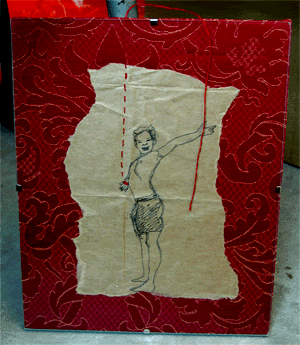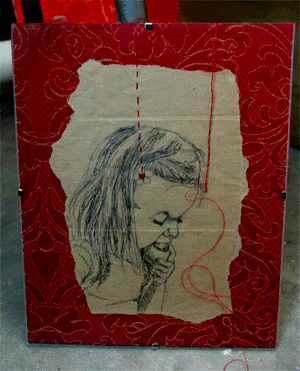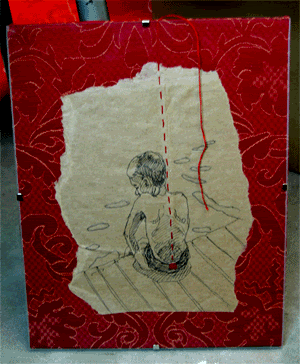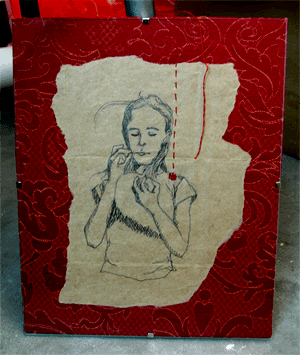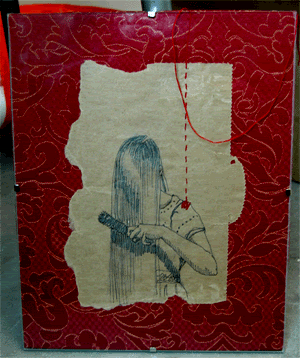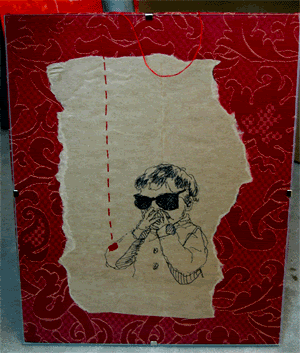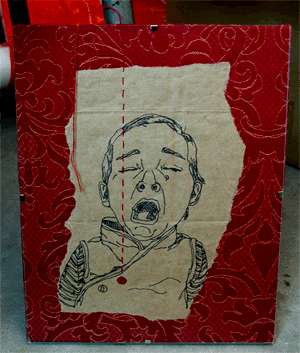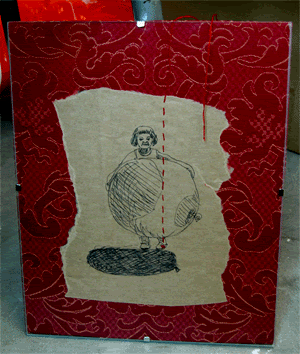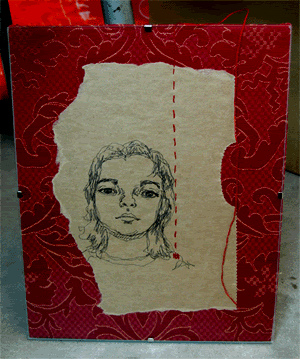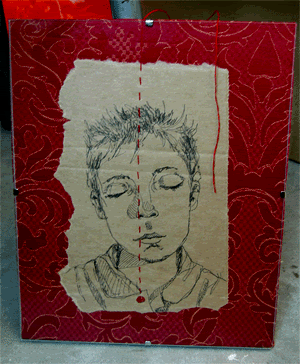rap musk
Tuesday, December 13, 2005
Tuesday, November 22, 2005
final project, in-process..
joey also suggested i go a bit further into the sketches i had done. originally, i thought of presenting images of children and children garments with strands of red wool to demonstrate the information of their location going back and forth from the satellite. instead, i might hand bind a book (thanks to the inspiration of Moon) and stich with red thread instead of using red wool. these are some of the "sketches" (i guess.. because they've got stichens in 'em)
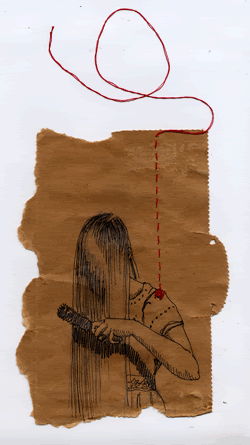
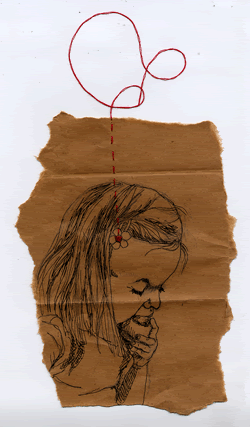
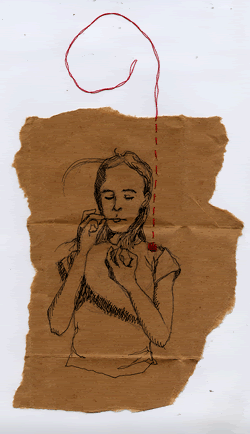
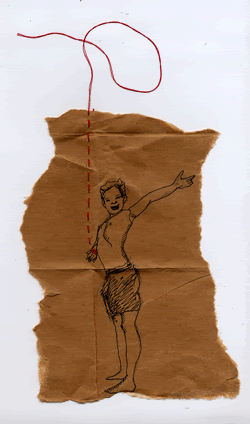
MAC visit
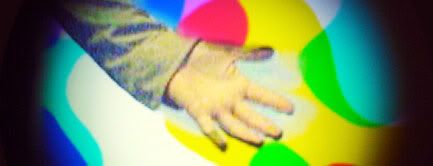
This interactive video installation by Alexandre Castonguay was truly astonishing, as it took our involvement to bring it to lif. One of the projections in particular had our motions create ripples in our surroundings, this idea stuck with me, it somewhat relates to the user interface I’ve decided to pursue, as it deals with reverberated signals, wavelengths, etc… Also, the interaction is immediate, you have an action and then a reaction, which renders it more efficient and more likely to be used.
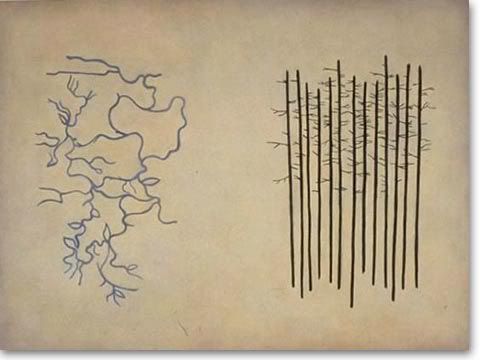
“Chemins” by Sylvie Bouchard
This painting by Sylvie Bouchard really grabbed my attention because of its aesthetic aspect; it is linear and deliciously so. The lines are organic as well, as they are reminiscent of lake mappings and tree forests. At the same time, we could compare them to the internet, using them as a visual metaphor. What I also enjoyed was the somewhat microcosm/macrocosm aspect of it, on the left; we could interpret the blue lines as an aerial view of a section of the earth. On the right; we could interpret the vertical lines broken by a few horizontal ones as a close-up of this section of the earth. I see this playing a role in my final project because it demonstrates how there are some many pathways to follow, so many entrances and exits, such that it is extremely easy to get lost. Especially for a child who relies on someone else for direction.
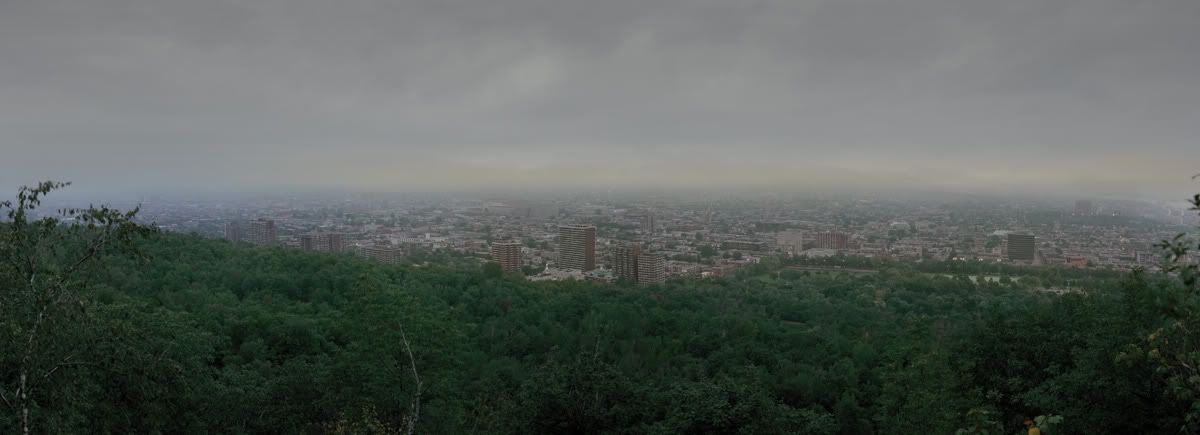
“Au seuil de la nuit” by Isabelle Hayeur
Isabelle Hayeur’s photographs are grand in scale and though they should be intimidating and imposing, they’re in fact very humble and gracious though a little unsettling. Partly due to the gray toned colors that are predominant in most of her photographs. She gives the landscapes very much human emotion qualities. The images also shed light on the juxtaposition of technology and nature that is a great part of a majority of people’s lives these days. It (the photograph) displays nature’s misery with immense beauty. This misery is the chaos that goes on within it, the injustice and crimes against humanity. As it has been said before: “Our children are our future”, how can there be a future, if there are no children? So if nature is engulfed in this chaos which creates a dangerous environment for the people roaming it, there indeed is a need for protection. That is how it would relate to my project.
final project proposal
So I started with an idea a close relative suggested, to have a bicycle with some sort of shield and better traction so that people could ride them in unfavorable bike riding weather. But that sounded better than it actually looked. Then I had the momentary glee of perhaps artificial trees, they would be implanted with surveillance cameras and the artificial leaves would detect local weather conditions as well as displaying them on a screen along with the time and other such useful information one might need in a location where one might only find a tree. But that seemed useless and like it would cost a lot of money more than anything else.
So finally I got to the idea I decided to run with; Child Tracking Devices. This first kind of came up with the daily paranoia my mother suffers from whenever my 9 year old step brother is due back from school. At 2:30 pm sharp she asks that either I (if I'm around) or my other step-brother keep an eye out for him as he walks down the street towards the door. I would tell her: "you need to have some kind of tracking system on that kid, it would keep your mind to rest!" To be blunt, I just don't think it's fun to stare out a window at a kid you know is going to reach the door by logical routine deduction. Unless of course someone decides to jump out from the bushes to kid nap him in broad daylight. Anyhow, the more I thought about it the more it seemed like a good idea. Why not develop some sort of tracking system for children? The microchips could be placed in little compartments on clothing, or accessories. They'd only be permitted to be used on a child up to a certain age, maybe 12. What with the countless number of children being kidnapped and disappearing each day, something needs to be done to protect them. The world isn't as safe as we want it to be.
In terms of the final piece aesthetic, I was thinking about getting some child clothing and various child accessories and placing them up on a wall. I would indicate the location of the microchip with red wool leading to a large drawn satellite which would then be connected to a large drawn earth (still with the red wool). I would include illustrations of where children could be while being tracked along with illustrations of how parents can get information about their child’s location. On some of the child clothing, I’ll add a red tag to the existing price tag, which would be a way to distinguish which items of clothing have microchip pockets already sewn into them. The idea is to give people the option of tracking their children, which gives them control (and a peace of mind) over the interface, not the other way around.
sketch :

*for the proposal : i used what i first wrote about the user interface design project and added onto it*
Tuesday, November 08, 2005
mmmcolors.
|  | counter clockwise from top left corner: hungry happy melancholy angry |
| 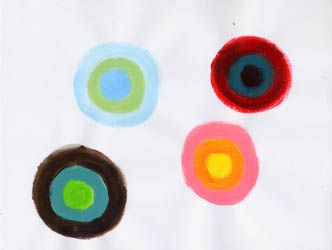 | counter clockwise form top left corner: melancholy angry hungry happy |
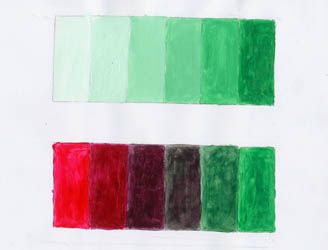
book
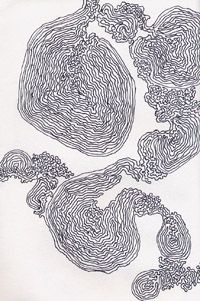

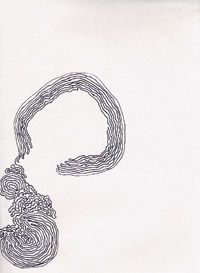
Tuesday, October 25, 2005
I choose fear.
what is fear? fear is an emotion that paralyzes us. it is an all encompassing emotion which, when experienced, is felt thoroughly. fear is also a feeling of being in danger. it is omnipresent in our every day lived as it is essential to our survival and has been for thousands of years (for instance, if we weren't somewhat afraid of dying, we would be less likely to stay alive). fear is also used to control people, such cases as domestic abuse and crimes against humanity are based on fear.
what is its properties? it set boundaries and constraints a person. it takes charge of a being and is a very strong emotion.
how does it function ? it can function when we feel as though we're in peril, in great danger or that there is some strong, unpleasant consequence ahead. it can also function within us as we do sometimes impose fear onto ourselves.
where is it located? i'd say it's located in the torso. it really inflicts enormous amounts of emotional pressure in that area. that could be because when we are fearful, our heart rate goes up and breathing becomes more fast paced and intense. personally, when i'm afraid, i feel as though my heart is in my throat.
here are some thumbnails..
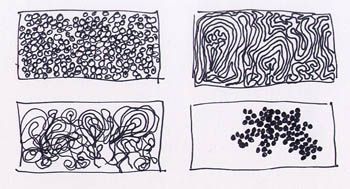
final piece :

p.s: pardon the lack of capitals. i'm feeling defiant.
pause
last week we spent about 4 hours on this one word. i couldn't believe it. i'm pretty sure we covered anything there ever was to talk about pause in the whole universe. which is a cool, conceptual thing.
so ofcourse this called for some visual/non lingual representation of the word.
the thumbnails (haha, thumbnails! ..) :

das vizualz :
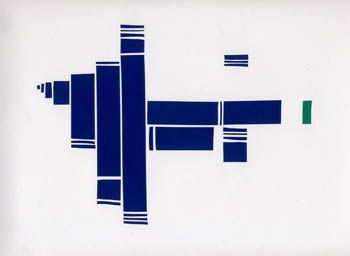
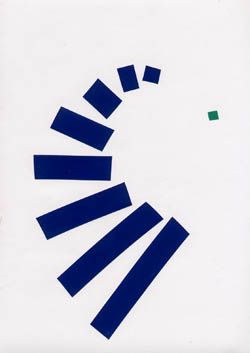

after we had ended the class with dimension talk, i started wondering what my life was like in another realm. perhaps i live in france and smoke cigarettes through long pipes all day. hm..
Wednesday, October 19, 2005
creating a new user interface
To be honest, I found this particular task of imagining an interface of the future to be quite difficult. Trying to think of something that seemed likely to be pursued had me revisiting ideas that have already been thought of. Naturally, I became a little frustrated. That is until i hit upon something that sounded plausible to me. I was thinking about having child tracking devices be a new feature of the future. Also, I do believe it is in line with some of the questions we had to ask ourselves whilst conjuring up these ideas. Like, "What do we want from machines?" I believe we want machines to better our lives, to help make daily tasks easier and not so simple tasks simple.
So I started with an idea a close relative suggested, to have a bicycle with some sort of shield and better traction so that people could ride them in unfavorable bike riding weather. But that sounded better than it actually looked. Then I had the momentary glee of perhaps artificial trees, they would be implanted with surveillance cameras and the artificial leaves would detect local weather conditions as well as displaying them on a screen along with the time and other such useful information one might need in a location where one might only find a tree. But that seemed useless and like it would cost alot of money more than anything else.
So finally I got to the idea I decided to run with; Child Tracking Devices. This first kind of came up with the daily paranoia my mother suffers from whenever my 9 year old step brother is due back from school. At 2:30 pm sharp she asks that either I (if I'm around) or my other step-brother keep an eye out for him as he walks down the street towards the door. I would tell her : "you need to have some kind of tracking system on that kid, it would keep your mind to rest!" Blantly, I just don't think it's fun to stare out a window at a kid you know is going to reach the door by logical routine deduction. Unless of course someone decides to jump out from the bushes to kid nap him in broad daylight. Anyhow, the more I thought about it the more it seemed like a good idea. Why not develop some sort of tracking system for children. The microchips could be placed in little compartments on clothing, or accessories. They'd only be permitted to be used on a child up to a certain age. Maybe 12. What with the countless number of children being kidnapped and disappearing each day, something needs to be done to protect them. The world isn't as safe as we want it to be. In this series I drew children wearing different tracking device exposed in red and i added reverberation lines to show how signals are being sent and received while the children lead their daily lives.
Sunday, October 16, 2005
Human Computer Interaction
(just letting you know that there are interesting links towards the end.)
While reading Michael Schmitz's article on Human Computer Interaction in science fiction movies, I must say that I didn't quite understand the term "interface metaphors" right away. This is funny because they are so common to us, ubiquitously present in every day computing. Eventually, it made sense to me, interface metaphors meant introducing a new interface by means of a form of communication and symbols which mass amounts of people are already familiar with. So for instance, as Joey has mentioned once before, a desktop computer isn’t really a desktop per se, since it isn’t a surface with physical working materials and four standing legs, it is a screen. However, its functionality is the same; it has folders, writing materials, calculators, etc... The computer desktop has become in many ways a replacement of the traditional desktop, an upgrade from it. Such is what new interfaces do.
When it comes to interface metaphors in science fiction movies, Mr. Schmitz goes through a multitude of titles spanning over half a century to show us how some have perceived the future throughout the years. Starting with a movie called “Metropolis” by Fritz Lang made in 1927. When it came out, digital technologies didn’t exist and mechanical industrialization was a predominant economic force. As it is noted by Mr. Schmitz, the movie centralizes on the mechanical aspect of innovation and points out a fault: the machines are run by humans in order to function. At its earliest, science fiction seemed not to be preoccupied with plausible realities, creating plots around technologies that are mapped with glitches and grounded on more fantastical avenues. Nevertheless, it’s interesting to note that circular motion is presented as the essence of mechanical function and technological advancement. The wheel has brought us many wonders and is evident around us to this day; bicycles, cars, clocks and come to think of it, compact discs are circles and their function involves a circulatory motion. Also, everything is huge in that movie whereas nowadays, everything tends to get smaller and smaller. Technology has taken a different path than what had been imagined. In fact, weren’t we supposed to have an array of silver wardrobe and fly around with jet packs by now?
Now that we’ve peeled this orange, let’s get to the good stuff. Mr. Schmitz has categorized various interfaces into; 1) “Neuro” Technology, 2) Identification, 3) Speech, 4) Displays and 5) other I/O interactions.
1) ”Neuro” Technology.
This refers to a technology that is connected to the brain. There are two movies in which this plays a role and both star Keanu reeves, funnily enough! The first is called “Johnny Mnemonic”, in which Keanu’s character, an agent, delivers sensitive data using a personal storage device, his brain. The way in which he transfers this data into is brain is through a connective wire he plugs into a socket underneath his ear. The other movie he was in; “The Matrix” also featured a character that connects and disconnects with a program. Although, unlike Johnny Mnemonic, it is not reality that prevails, the program is the sophisticated one. This blurs the line between reality and cyberspace. How do we know which is actually real? That’s what it had me thinking anyhow.
2) Identification.
I find it interesting that technology is sort of founded on individualization, preoccupied with pin pointing every single spec of human existence on the earth. This, I believe is what defines its advancement. But on the flip side of the coin, lack of privacy becomes an issue. Constantly being watched by a sort of sleepless surveillance can be bothersome. Kind of like in George Orwell’s “1984”, big brother is watching us. Identification is evident in science fiction movies, recognizing an individual by means of their finger prints, hand prints, eye scans and breath. One biometric identification system that seems more cult-like than futuristic is that of having a diamond-like implant in a person’s palm that changes color throughout various stages of their life and kills them at the age of 30. This so-called perfect society in “Logan’s Run” whose only purpose is enjoyment sounds like a mass of ticking time bombs to me. I don’t think I’d like this movie. Nevertheless, identification is in fact part of current technology, replacing i.d cards and passports in certain country airports, where a simple eye scan avoids all the hassle. I’ve also seen fingerprints already being used for home computer security. Biometric identification certainly is a step forward but only if it is used responsibly. Hopefully it won’t reach a level of utter invasion as it does in “Minority Report” and “Gattca”.
3) Displays
There have been a few pioneers in science fiction movies when it comes to displays. As Mr. Schmitz mentions, displays are inherently visual and that’s why they naturally have found their place to evolve in movies. Namely, in “Total Recall”, displays are used in every day life, as common as flat screen pcs and cordless mice are to us today. Displays also arise in the “Star Trek” series. Coincidentally, a technology explored in the series was being researched in real life. This is a good example of how more recent science fiction movies/series have become much more innovative than in past years. Also, displays begin to take a more 3 dimensional form in movies like “The Matrix”, “Minority Report” and “Star Trek: The Next Generation”. Holograms for instance seem to turn something internally dynamic into something externally and visually dynamic. As humans when we interact with things, they occupy a presence. Displays help us communicate with interfaces eye to eye.
4) Speech.
Speech plays an important role in intelligent technologies. Perhaps in a symbolic sense, it is a way to retain the fact that we are above them because they didn’t appear out of thin air, a collective had to think it all up. Also it frees our hands from manipulating the interface allowing us to accomplish various tasks by means of sentences. Computers are capable of withholding a magnificent amount of information that is to our disposal. I truly enjoyed that scene in “The Time Machine” where the traveler goes forward in time and is guided through a library by an avatar. I agree with Mr. Schmitz when he says this creates an environment of augmented reality.
5) Other I/O interactions.
Finally, in speaking of augmented realities, there are numerous examples of this in a multitude of science fiction movies. In “Johnny Mnemonic” and “Minority Report” hand gestures are used in interfaces to open, close and move things around. The interaction becomes much more fluid and somewhat tactile. This actually reminds me of a video I saw a little while ago where and interface has been created to be used with tiles that interact with each other. Thanks to re-locating the site I found it on, I found the link to the video as well, take a look!!
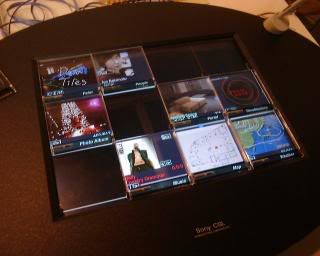
{link to movie}
for more go {here}.
I’m surprised the article didn’t mention anything about “I Robot”, a movie that came out quite recently. I think it is a great example Human Computer Interaction where there is an interdependence between human and machine. But as we see in many science fiction movies, nothing is perfect. While searching google for HCIs, I came across an electronic artist called Laura Maccary who’s work brought up technology’s dichotomy. Have a look-see :
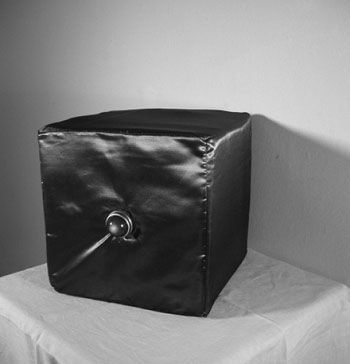
{link}
ARTIST: Laura MacCary
TITLE: Huggable HAL
MATERIALS: Electronics, glass, fabric, foam
DIMENSIONS: 9 1/2" x 9 1/2" x 9 1/2"
DATE: 2005
DESCRIPTION AND STATEMENT
This HAL references the HAL 9000 computer from the movie 2001. Each HAL is a cube or block about ten inches on a side, with a glowering red eye that lights up when you hug it, but the eye fades unless you keep hugging. Ironically, hugging them forever would eventually run their batteries down, sort of a damned if you do, damned if you don't kind of thing.
I'm thinking about our relationship with technology, how intimate it is, how we anthropomorphize, and as the movie points out, how technology is a double-edged sword. For me there is some conflicted pathos in hugging or consoling this murderous/helpless device. Who is manipulating whom?
To conclude, the innovations that thave been brought to our attention by science fiction movies and every day technology ressearchers are constantly going to try to transform our lives into something more and more digital. Question is, how digital are we willing to be?



